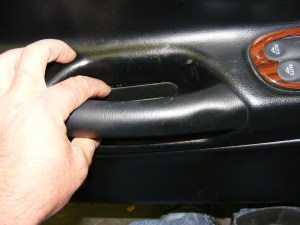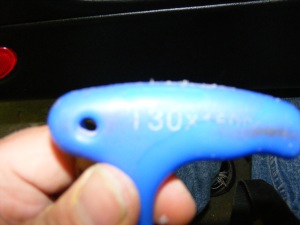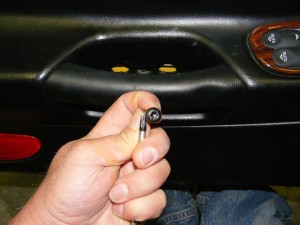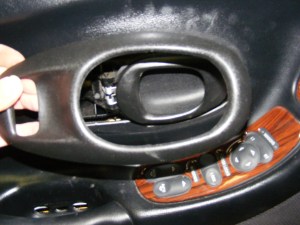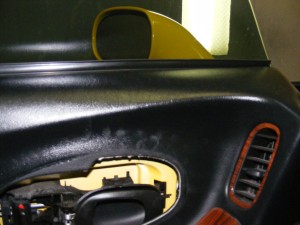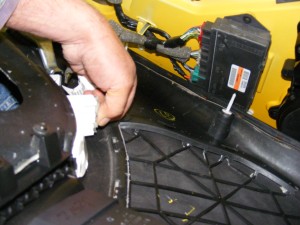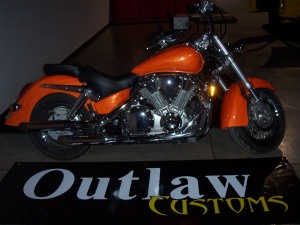How to Repair a Dent Yourself. (The Correct Way)
Ok, here we go. If you are really contemplating repairing a dent on your own vehicle, Or maybe one of “your soon to be” ex friends has conned you into repairing a dent on their car. I am “hopefully” here to give you the best and most informational article on the web. Maybe when you see what is actually involved in repairing a dent correctly you may, or may not decide to leave it to a professional. In the event you are a gluttin for punishment and still set on doing the repair yourself, at least you will have an idea what you are getting yourself into. I am going to give you the steps and also links to and prices of some of the tools and materials needed to do the repair. The repair I have chosen to document for you is a 01 Chevy Tahoe, one of the easiest repairs I have done in a while, so yours, most likely will be more difficult. Don’t let that discourage you. Most of the information here works for all small to medium dents that you do not have access to from behind. The dents that have good access to them (from behind the panel) are usually much easier to repair.
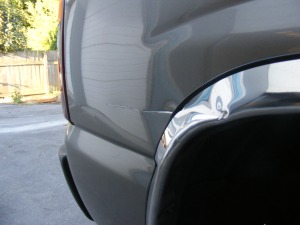
Sizing up the dent
Step 1. Decide how you are going to repair the dent and what tools will be involved. This is a very important part of the job, if you know what you are going to need to do the repair, you will then be able to job cost more effectively, thus deciding if it is still worth your while to continue with your plan. Also decide where you are going to do the repairs. A large heated well lit garage is much more comfortable then outside in the snow and rain, or under a shady tree with sap dripping on your head and a couple of flashlights duct taped to your Chip Foose baseball cap. basically make sure you have a game plan ( all your ducks in a row).
Step 2. Remove all the parts that will be in your way to do a clean, quality repair. On this Tahoe I removed the dented after market wheel opening molding first so I could get the repair on the dent started as soon as possible.
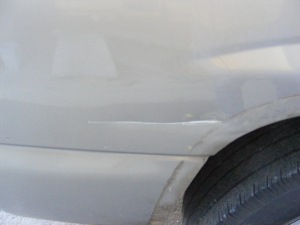
wheel flare removed for repair
The customer needed his car as soon as possible, so I offered to work through the weekend to accommodate his needs. We also need to remove the tail light, but since it was not in the way of the repair I decided to wait until I had the filler drying to do so. The rear bumper and 1/4 glass should also be removed for the best paint results but in this economy the customer decided not to pay for that operation to save money. The down side to not removing the window is that it is impossible, to sand and get paint under the window molding, and that leaves a slight chance of the clear coat eventually pealing away around the window molding. The down side of not removing the bumper is that it is very difficult to get the paint wet, or shiny, behind the bumper as paint guns do not shoot around corners very well and tend to leave dry spots around shadowed areas like behind the bumper. Now that you have removed the necessary parts you can start the repair process.
Step 3. Put on a dust mask or preferably a respirator. Remove all of the paint from the lowest point of the dent to be repaired, I prefer to remove just enough paint to get the Spitznagel nails to work, ” hey I didn’t name it but I am sure glad they invented it” I will cover what a Spitznagel is in a moment . The best reason I can give for only grinding the lowest area of the dent is that it is a lot easier to see how the dent is coming out if you still have some shiny paint to get light reflections off of.
It is almost impossible to see a dent on ground or sanded sheet metal. The reason I had to grind this repair for the Spitznagel is that the panel I am repairing does not have good access to the back side for traditional hammer and dolly treatment, personally my favorite way to repair a dent. After grinding off the paint, make sure to grind off the galvanizing, The Spitznagel nails will not stick well to galvanized sheet metal. the galvanizing looks a little duller and grayer then the bare metal, make sure to blow off all the dust with an air blower.
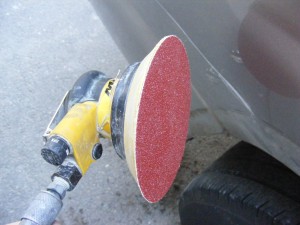
D.A. or dual action sander with 40#grit sand paper
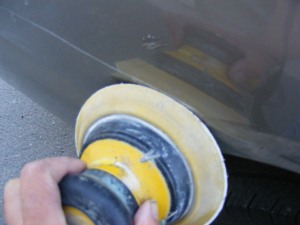
Sanding out the low spots
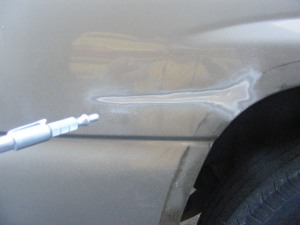
Using an air blower to remove the paint dust
Step 4. Now it is time for the nail gun (Spitznagel), there are many stud guns and many styles to choose from, and the prices are much less expensive then they were ten or twenty years ago. Shop around and you can get a good deal on one, they are a invaluable tool for any one repairing dents in metal surfaces that can not be accessed from behind. Place the nail in the gun and touch the center of the nail to the low spot you wish to pull out. Apply pressure to the gun to depress the spring so the grounding ring on the nail gun touches the bare metal and pull the trigger. Be very carful not to hold to long or you can blow a hole in the metal or heat up and warp the metal, (both are bad).
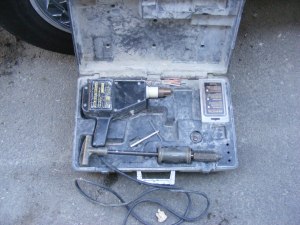
The stud gun (Spitznagel) I used to repair this dent
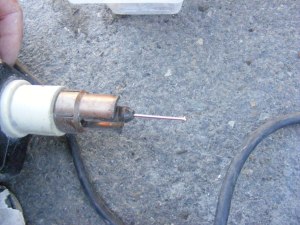
Placing the nail into the gun
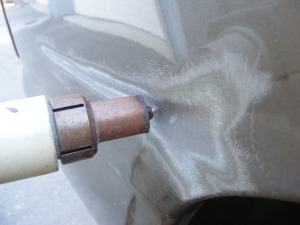
Ataching the nail to the dent
Put as many nails on as necessary, pull the dent slowly and carefully trying not to stretch the metal out of shape. after you have pulled the nails you can twist them off and repeat as many times as necessary until the dent is as close to straight as you can get it.
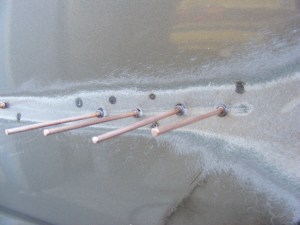
Nails in place
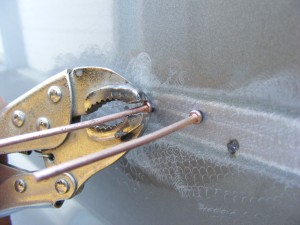
Removing the nails
You can use a metal file or sand paper on a hard block to sand over the repair and check for high and low spots. tap down the highs and pull up the lows. once you have got to the point that you have absolutely no high spots and very few lows you are ready for the next step.
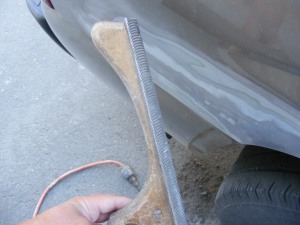
A rounded metal file works well for fiding high and low metal
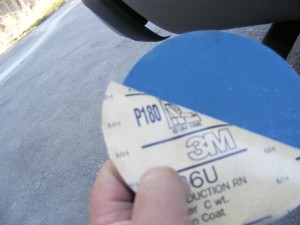
180# grit D.A Paper
Step 5. grind out at least 2 inches past the dent that you are repairing with no finer than 80# Grit sand paper preferably 40# or 60# after you have ground off the paint past the repaired area, you need to feather edge the paint, I started with 180# on a D.A. (dual action sander) and finished of with 320# on the same D.A..

Feathered paint has soft edges ,no sharp looking edges
Step 6. Now after all this work you are ready for the filler. This is not the hardest part of the repair, although it is the one part most of the so called ” Internet Auto Body Experts ” get very wrong. There are two major reasons to disregard some of the Auto body shop information on the web. The number one reason to ignore the information put out by an individual telling you how to repair a dent is to see them mix body filler with the same tool they are going to use to apply the filler. This is a complete rookie mistake. If you choose to mix filler in this fashion I guarantee you will end up with a lot of unmixed filler and catalyst in your repair that will eventually lead to a failure. The number two reason is the use of non catalyzed spot putty, this is made for lazy people who don’t care what their repairs look like three weeks down the road. Always use catalyzed material if you want Your repairs to last. First get yourself a good mud board, a piece of flat glass works well, and there are many other mud boards you can purchase. Be aware that if you plan to use cardboard make sure it has a little shine to it, like a wax coating or similar, you don’t want those pesky little cardboard hairs in your filler. Also purchase a good spreader, one that fits the dent you are repairing, plastic spreaders work good for small dents and metal spreaders are excellent for larger ones. Here to you need to plan ahead, remember clean up supplies, unless you want to use disposable equipment, Lacquer thinner, solvent proof gloves, a scotchbrite, and some paper towels or a shop rag. get this equipment ready as your filler will be drying fast. Have you made sure your panel is ready for the filler? The dust blown off and the panel wiped down, preferably with a grease and wax remover. Decide how much filler you are going to need make sure you have more than enough to fill the dent, filler is inexpensive and not mixing enough does you no favors. once you have the right amount of filler on your mud board immediately put the lid back on the can of filler, you don’t want dust or worse yet dirt in your new can of filler it will make it useless. Now it is time to add the hardener. This is the part of the job that is hard to explain. Even the companies making the stuff are vague, a dollar size of filler to and inch of hardener? how thick ? a Paper dollar or a silver dollar? A pen thickness inch of catalyst or a kindergarten pencil inch of hardener. See what I mean? Is that in 60 degree weather or 90 degree weather I know they usually say 75 but that usually only happens 10 days out of the year hear in Portland Oregon. You will just have to practice and adjust, remembering that the temperature really effects the dry time. the picture that I used for the mud on the Tahoe was on about a 70 degree day and I mixed it a little slower then usual to give me some extra time to take the pictures. Mixing the filler, the key, is to get it mixed as quickly as possible with out putting air bubbles in to it, easier said then done. I use a back and forth kind of snake motion with a flexible putty knife applying pressure to try and squeeze out any bubbles I create when i flip the filler back on top of itself. This will feel a little awkward at first but the more you play with it the easier it will get. Now that you are confident that your filler is mixed and most of the bubbles have been squeezed out your sitting there with you putty knife stuck to your mud board with a rock hard glob of bondo cursing me out for not being able to tell you you used to much hardener or you took to long to mix it. Sorry, but look at the bright side it is much worse to have not used enough hardener and applied it to your repair having to eventually scrape it all off with a putty knife and lacquer thinner rags because four hours and a twelve pack later it still shows no sign of hardening. So its probably better to have it harden before you putt it on the dent than not to harden at all.
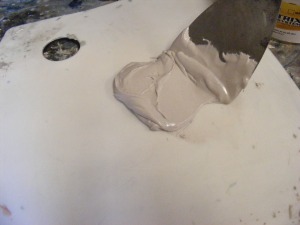
Make sure to use a good quality filler
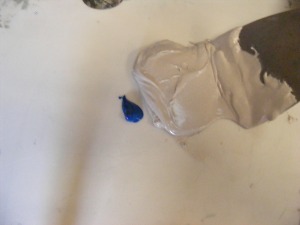
Adding hardener (I like blue because some reds bleed pink on white paint jobs)
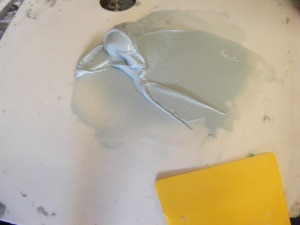
Mix well
Applying the filler, is another area that just takes practice, you will most likely get frustrated with the fact that you are trying to fill the dent without leaving huge ugly paddle marks while making sure to squeeze out all the air pockets, and also leaving enough filler to sand down to the height of the original panel. (And some women say I can’t multi task). Remember I am a body man not a photographer so It may be hard to see the paddle lines in the mud work but My Pictures should at least give you a guideline as to what the filler should look like if applied correctly. Remember that the smoother and straighter you put the filler on, the easier it will be to sand off and the better the repair in the long run.
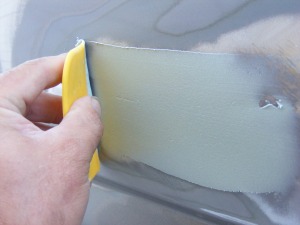
Apply the filler as smooth as possible
It helps the repair process if after you get the filler where you want it, you scrape off any unwanted filler from the edges, like around wheel wells and door edges. If by chance you slung some bondo where you shouldn’t have, wheels, glass, another panel, plastic parts, the neighbors dog, don’t touch yet. go clean your mud board unless it is a disposable one, then just clean your putty knife and spreader making sure not to scratch the edge. A gouge in the edge of a spreader deems it not usable, you will never get a smooth finish on the filler with a gouged spreader. after you have made sure your tools are clean go back and watch the bondo dry. I am not kidding, if you have selectively placed some filler wear it need not be, stand a close watch. There is a time window where the filler is almost completely hard but can just be peeled off without staining or completely sticking, use that window to remove unwanted slag. If you have made it this far treat your self to a beverage
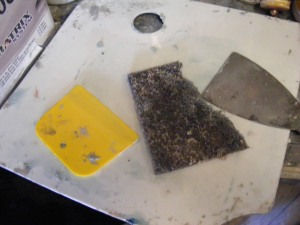
Clean with lauquer thinner, scotchbrite and paper towels. (Make sure to wear solvent proof gloves)
Step 7. remove the rest of the parts for paint while the bondo is drying.
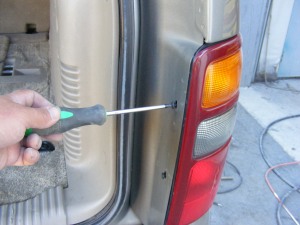
Remove the taillight while the filler is drying
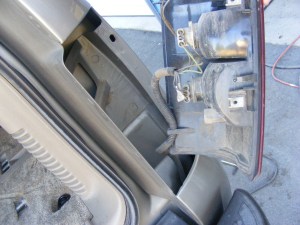
Unplug the sockets
Step 8. Sanding the filler, First part of the sanding process is by far the most difficult to learn or to teach, because straight and smooth are not in anyway related. but as I have found through the years teaching body helpers, every one of them thinks if it feels soft and smooth it must be straight. Well the most important thing to remember when sanding your filler is (smooth is definitely not related to straight). Think of the proverbial “Smooth or Soft as a baby’s butt”. although a baby’s but may be both smooth and soft I have to this day never seen a straight one. So how do we get our body work straight? First off we find a sanding block that is ideal for the panel we are straightening, I tend to say to use the flattest, most ridged, and longest block that you can use without excessively scratching outside of the repair area. But as in all facets of body repair there are exceptions to the rules. sometime a small soft block works well in compound curves, and rubber hoses in reveres style lines. For this repair I am using a standard small rubber block and starting with 40# grit sand paper. I always recommend starting with 36# 40# paper when you are learning, as it will be much easier to get the panel straight with. Remember Straight is what we want first, not smooth. Smooth will come after we get things straight. When sanding always sand diagonal to the sanding block, almost never sand vertical or horizontal to the block as it will leave gouges in the filler. if you sand vertical just turn the block diagonal to the sanding motion, also crisscrossing your sanding directions will help you to see what your panel is starting to look like. I would love to be able to teach you how to feel the difference between a straight panel and a not so straight panel over the web but that is something you will have to learn on your own. I will bet you if you drive your car to the local body shop and ask them to feel if your repair is straight they would feel it for you, and give their opinion to you for free, I know I would at my shop.
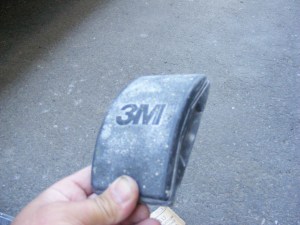
Standard 3M rubber sanding block
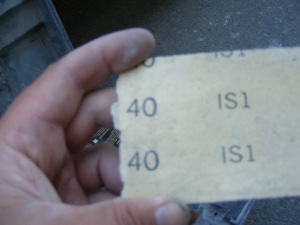
40# grit sand paper
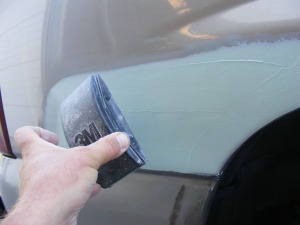
Block is diagonal to sand vertical or horizonal. block is held vertical or horizonal to sand diagonally.
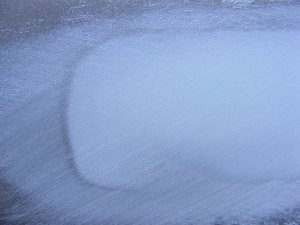
The filler will look feathered when you are getting close.( the middle lower area looks good but the left side and upper area still has sharp edges requiring more sanding).
A great way to tell how your dent is shaping up is the use of guide coat. They do make a product especially for this purpose but any fast drying rattle can paint will do the job. The idea behind guide coat is that when you spray it on the repair it will leave a light dusting of color on the repair, as you sand the panel with the flat block it removes the paint from the sanded area leaves the paint in the lower dented and scratched areas. You can continue to block the filler trying to keep a good flat sanding style until you sand far enough to remove all the guide coat.
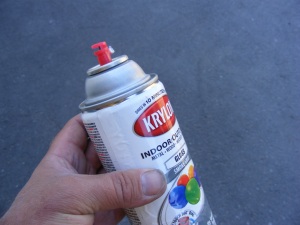
Any fast drying rattle can should work for guide coat. they also make an actual paint called guide coat.
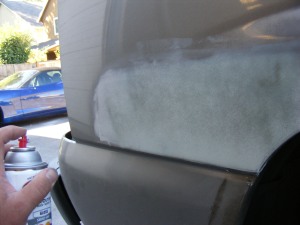
How the guide coat should look after applied.
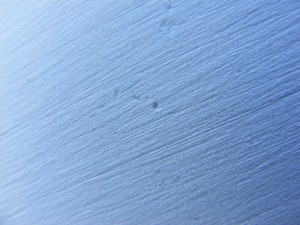
Closeup of guid coat showing pinholes and sratches.
If you start to see metal showing through the filler before you get all the guide coat removed then you have a high spot in the metal or not enough filler in the low spot. This is for you to try and determine, you are going to have to use that thing call common sense. It is usually a combination of both high metal and low metal, tap down the high spots and apply more filler to the repair.
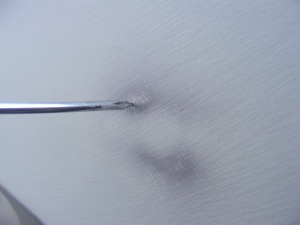
High spot starting to show, be carefull not to tap down to far.
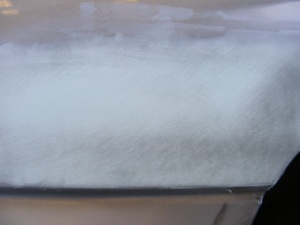
Getting close
I would always recommend recoating the entire repair area vs. just trying to fill the low areas. My reasoning behind doing it this way is because each time you mix the filler you will have a slightly different mixture resulting in a slightly different dry time. So each coat you apply sands at a slightly different rate, this means it is much easier to get one even coat of filler straight then a bunch of little patches straight. once you have got the panel close to straight then guide coat the filler again and switch to 80# grit sand paper and block down the filler to remove the 40# grit scratches. check for pin holes and scratches closely if all looks and feels good guide coat one more time and block with 120# grit to knock some of the 80# grit scratches down a bit. Now if every thing looks and feels good, no shiny metal, no big scratches or pin holes, no guide coat showing a dent, you are ready for the Painter. Now this is when you sit down with another beverage, and contemplate what you have accomplished.
Wait this is no time to celebrate you may have just repaired your dent flawlessly but I left out one major Internet how to misinformation. No reputable auto body shop I know of will paint something that was not repaired by their technician at their own facility. Even if you have one quality shop repair your dents and try to take it to another quality shop to have it painted you will almost all ways be turned away. The only way a shop can guarantee there work is to do the complete repair, and since their reputation may hinge on their quality of work it is just safer for them to turn you away vs. risking their reputation on someone else’s repair work. So what do you do now? You made it this far and hopefully still have all your fingers and toes, why not get some of the glory and paint it yourself. I will walk you through the steps so what do you have to worry about? dust, dirt, fish eyes, runs, drips, color matching, blending, dry spots, chemical reactions, cost of materials, your health both mental and physical, and I am sure I missed many more issues that may arise, but don’t let that stop you. You made it this far and I am sure you don’t want to drive around with soggy bondo on your car the rest of your life. So its time to jump in with both feet. Kersploosh!
Posted in 1
